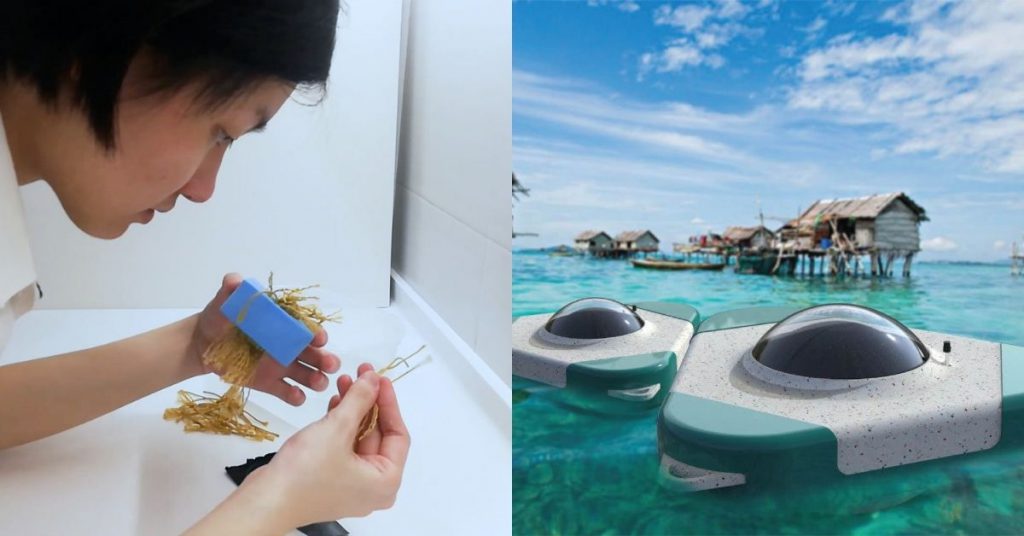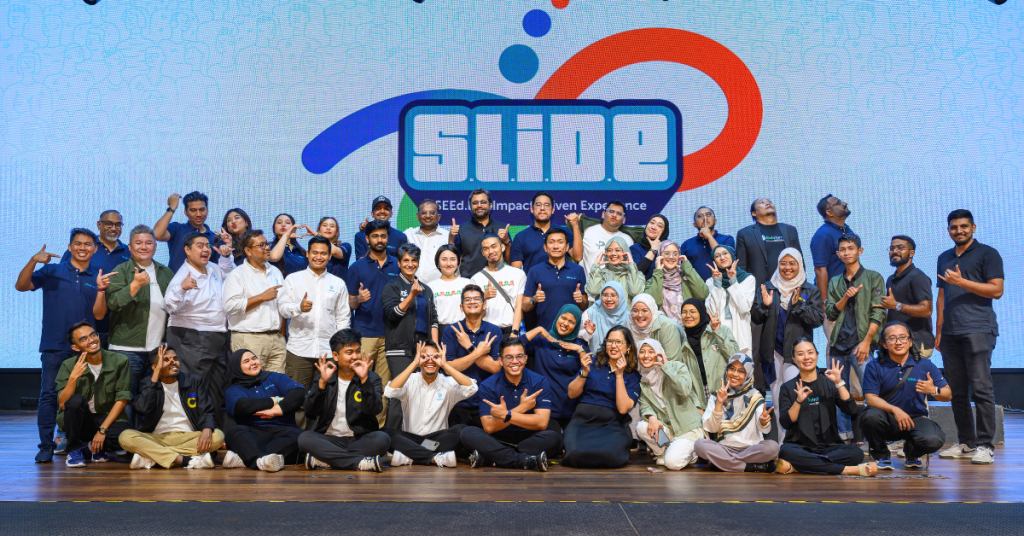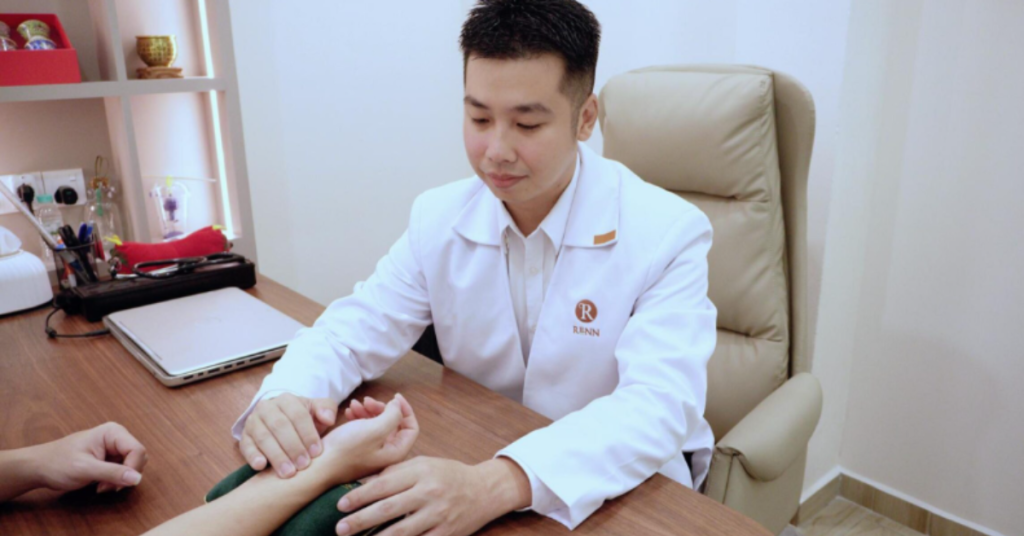The James Dyson Award (JDA) is an annual product design competition that runs in 28 countries and regions, with Poland being a newcomer this year. Design engineering university students are invited to submit and pitch their innovations that solve a problem, and this year’s theme pertains to environmental sustainability.
In an exclusive virtual roundtable interview, Vulcan Post learnt that this year’s Malaysian national winner is WaterPod, a sustainable desalination pod that turns seawater into drinkable water naturally.
WaterPod was designed by 21-year-olds Bennie Beh Hue May and Ash Yap Chun Yoon from Selangor, and Elson Loo Xin Yang from Johor. The 2nd-year students are pursuing a Bachelor in Product Design at Asia Pacific University KL, and the classmates have never met up in person due to the MCO.

Both Bennie and Ash credited their design knacks to their parents, the former’s mum being an interior designer while the latter’s dad dabbles in the arts. Meanwhile, Elson looks up to designers like Naoto Fukasawa and Dieter Rams who continue to inspire him on his design journey.
The water problem at sea
According to the World Health Organisation (WHO), one in three people globally—including sea nomads—lack access to safe drinking water.
Did you know: Sea nomads is a term typically used to refer to the Bajau people who’ve lived at sea for more than 1,000 years on small houseboats that float in the waters surrounding Malaysia, Indonesia, and the Phillipines. They’ve been called “super divers” too, because they’re extremely adept at diving due to their lifestyles and larger spleens. In depths of 200 feet, they can stay underwater for as long as 13 minutes.
The Atlantic / National Geographic
Contaminated water poses health risks that have the potential to cause diarrhoea, cholera, typhoid, and intestinal worms, to name a few.
Bennie, Ash, and Elson noticed this issue after getting in touch with Malaysia’s Sandakan sea nomads through their lecturer who’s involved in an NGO serving the community. The team explained that many of them were fishermen who lost their livelihoods during the lockdown.

Further complicating the problem are the great distances people have to travel just to obtain drinkable water by bartering for it at a nearby town with collected rainwater.
“Incidentally, the sea nomads also collected a lot of plastic bottles littered at sea but did not know what to do with [them],” the team explained.
The students told Vulcan Post that they were initially tasked with designing a product that can be recreated by the sea nomads out of plastic bottles. Upon diving deeper into research, however, they decided to crack the root of the water problem by giving the community access to clean water to help improve their living conditions.
“Ideally in our plan, the WaterPod should be able to be produced from recycled bottle materials. If the project is successful, we will then explore how to set up a system to clean and recycle the bottles collected so that they can sell [them] and use [them] to produce WaterPod,” they hoped.
Making seawater drinkable
WaterPod is a sustainable desalination pod that works on solar distillation to convert seawater into drinkable water. It is designed to be floated at sea, and therefore accessible to the sea nomads.
Harnessing basic science, the students got WaterPod’s structural design by looking at nature. Inspired by a mangrove tree’s roots, WaterPod uses a salt-rejecting wick below the device that absorbs seawater, and transports it to a black fabric placed on top of a semi-spherical aluminium plate.

With the sunlight’s heat, seawater will evaporate from the fabric onto a transparent dome cover on top. Ambient air surrounding the cover will cause condensation to take place. The ocean’s waves will create the energy needed to shake the vapour collected on the dome, and water droplets will tip into a storage chamber below.
Finally, clean drinking water can then be retrieved through a water pump system.
Plans to make it full-scale
Due to the MCO, the team wasn’t able to do a full-scale test for WaterPod. They’re hoping to secure funding from public or private investors to pursue further R&D.
Should the team push their project further, WaterPod will function as a cost-effective alternative to existing desalination plants. Their innovation will also have a modular concept that can connect multiple pods at sea together to enhance their buoyancy and stability without flipping over.
To tackle plastic pollution at the same time, the proposed full-scale WaterPod will use recycled plastic materials collected from the ocean as its body’s mould.

Since the WaterPods would be out at sea with no shade, we wondered if there was a concern about the plastic melting. When asked, the well-read students assured that that wouldn’t happen as plastic waste floating in the ocean already requires 450 years to fully degrade. Furthermore, a high temperature of 200°C is also needed to melt the plastic.
Additionally, the transparent material selected for the evaporation chamber is a high-grade plastic material, polycarbonate, which is of an industrial standard meant to withstand the sun’s heat.
“However, even though WaterPod will not melt under sunlight, the pod might degrade because of the ultraviolet [rays] from the sun. Worst-case scenario, we can coat the pod with a UV protection sealant to prolong the product’s life,” the team suggested.
Building a version of WaterPod with the proposed materials would require the students to collaborate with proper manufacturers who have the resources to build it full-scale. Based on the team’s computer simulation, a working full-sized WaterPod should have a water storage capacity of 30 to 40 litres.
What the runners-up had in store
Other than the national winning design, the two runners-up had interesting inventions targeted at reducing waste too.

The No Residue Bottle is meant to fix the issue of conventional pump-action bottles that are ineffective in getting every last drop of solution out of the container. It was designed by Wang Huangyutian, an international student from China in her 4th semester of industrial design at Limkokwing University, after her own struggles with shampoo bottles.

Meanwhile, Citra, The Bio Leather (CBL) is designed by Menlin Ng Aniathul Fitri, a 24-year-old Sabahan student majoring in Product Design at Universiti Sains Malaysia KL. Her product redesigns a sustainable pouch made out of bio leather from discarded citrus peels. This pouch can be then used as beauty product packaging.
Both runner-ups are planning to commercialise their products, but will first work on refining them.
Featured Image Credit: Bennie Beh Hue May, team lead of WaterPod, Malaysia’s national winner for the James Dyson Award 2021















